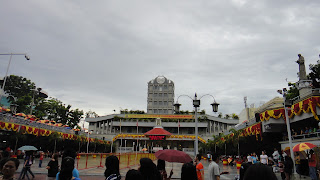1. Cebu Metropolitan Cathedral
The Cebu Metropolitan Cathedral is the ecclesiastical seat of the metropolitan archdiocese of Cebu. It honors as its patron Saint Vitalis, an ancient martyr whose feast day on April 28 coincides with the very same day that the image of the Santo Niño de Cebu was found almost 450 years ago by one of Miguel López de Legazpi’s men and the elevation of Cebu to an archdiocese.
The architecture of the church is typical with baroque colonial churches in the country — squat and with thick walls to withstand typhoon and other natural calamities. Having a cruciform layout, its facade features a trefoil-shaped pediment which is decorated with carved relieves of floral motifs, an IHS inscription, a shell symbolizing baptism, and a pair of griffins. The topmost part of the trefoil pediment contains two statues representing Faith and Hope. The Spanish Royal Coat of Arms is emblazoned in mid-relief above the main entrance owing perhaps to the contribution of the Spanish monarch to its construction.
from The Heritage of cebu
2. Basilica de Santo Nino
The Basilica Minore del Santo Niño is the first church and monastery to be established in the Philippines. It is also the center of devotion of the oldest Christian representation in the country of Jesus as an infant king.
When Spanish conqueror Miguel Lopez de Legazpi landed in Cebu to establish a settlement, one of his men found in an unscathed house a wooden statue of a child with European attributes. Believing that it was an image of the child Jesus left by the explorer Ferdinand Magellan decades earlier, Legazpi then ordered the construction of a church at the site where it was found so that it can be enshrined. Originally called as San Agustin Church, Pope Paul VI elevated it in 1965 to the rank of a basilica minore in honor of the Santo Niño de Cebu.
every much like Rome where masses are conducted outside the church
Aside from the 480-year old image of the Santo Nino, the church also has an exquisitely carved multi-level wooden altar screen or retablo which features niches that each contain a particular Augustinian saint or blessed. The church originally had four altar screens which included two on both sides of the transept but these were removed after the major renovation works which were conducted on the church for the 1965 celebration of the 400th anniversary of the Christianization of the Philippines. Gone too was an elaborately carved wooden pulpit and the 18th-century pipe organ. However, the wooden choir loft that features latticework carvings and the carved staircase at the monastery with newel posts that are each topped with Fu-Dogs have been remarkably preserved.
The church has a single three-level belfry attached to the northern end of the facade. At the south is a palatial two-level monastery with a courtyard in the interior. Right across the church is the contemporary “Pilgrim Center” built in the early-1990s to serve as an extension of the stone church, albeit physically separate. The pilgrim center also houses the Augustinian Province of Santo Niño de Cebu, one of the many geographical and administrative subdivisions of the Order of Saint Augustine.
from The Heritage for Cebu
after the mass
3. Magellan's Cross
The Magellan’s Cross is the spot which was believed to have been the site where the explorer Ferdinand Magellan planted a cross upon arriving at the shores of Cebu. The site was improved in 1735 by Father Juan Albarran, then prior of the nearby San Agustin church (now the Basilica Minore del Santo Niño).
In 1834, a kiosk was built to house the cross which in turn was also encased in Tindalo (Afzelia rhomboidea) wood upon the order of Bishop Santos Gomez Marañon when devotees began to chip it off piece-by-piece believing it had miraculous powers.
from The Heritage of Cebu
4. Tabo-an Fish Market
We ended our city tour at the fish market where we bought a lot for our families. :) One of my favorite breakfast is dried squid and danggit. Here we also proved that speaking in the native language goes a long way, haha! :)

















